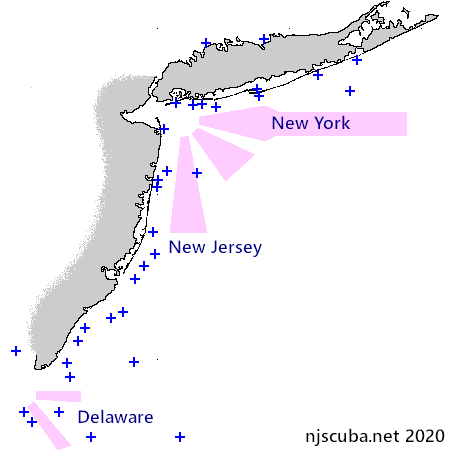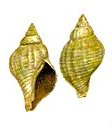Marine Life Colonization of Experimental Reef Habitat (5/5)
LIST OF TABLES
| Table 1 | Mean dimensions of 10 experimental reef habitats, 1998-2001 |
| Table 2 | Mean abundance and biomass per m2 of species colonizing experimental reef habitats after 24-96 months on the sea floor |
| Table 3 | The relative mean abundance of individual organisms by taxa per m2 footprint of experimental reef habitat during 1998-2004 |
| Table 4 | A comparison of sessile epifaunal colonization of four common reef-building materials - concrete, rock, rubber and steel - for sampling years 1998-200 |
| Table 5 | Statistical analysis to identify significant differences in epifaunal standing stock biomass on four reef substrates |
| Table 6 | Statistical comparison of standing stock biomass of two species, Balanus spp. and bryozoa, that exhibited significant differences in colonization of four reef substrates |
| Table 7 | A comparison of sessile epifaunal colonization of four common reef-building materials - rubber, steel, concrete and rock - located inside and outside of a 2.5cm mesh cage, 1998-2004 |
| Table 8 | A summary of reported standing stock biomass (g/m2 wet weight) values (rounded) for the benthic infauna and epifauna on sand sediments of the New York Bight |
LIST OF FIGURES
| Figure 1 | Experimental reef habitat |
| Figure 2 | An experimental reef habitat ready for deployment |
| Figure 3 | Top view of experimental reef habitat unit |
| Figure 4 | Location of reef structures around experimental reef habitats |
| Figure 5 | Thirty experimental habitats en route to the Barnegat Light Reef study site |
| Figure 6 | Divers sent the encapsulated habitats to the surface using an air lift bag |
| Figure 7 | Divers encapsulated the experimental reef habitat units inside a plastic drum, trapping most marine life inside |
| Figure 8 | Retrieving an experimental reef habitat unit encapsulated in a plastic drum |
| Figure 9 | The experimental habitat units were placed in a plastic collection pool before being dismantled |
| Figure 10 | The wire mesh cage is cut open to access experimental substrates |
| Figure 11 | The opened habitat unit showing whelk shells and corrugated panels |
| Figure 12 | The opened habitat showing upper chamber |
| Figure 13 | Marine life growth on whelk shell |
| Figure 14 | Marine life growth on concrete colonization plates located outside mesh (top) and inside mesh |
| Figure 15 | Marine life growth on rock colonization plates located outside mesh (top) and inside mesh |
| Figure 16 | Marine life growth on rubber colonization plates located outside mesh (top) and inside mesh |
| Figure 17 | Total number of taxa inhabiting experimental reef habitats analyzed during 1998 through 2004 |
| Figure 18 | Total number of taxa identified at least to generic level inhabiting experimental reef habitats for sampling years 1998-2004 |
| Figure 19 | Total number of taxa identified to specific level inhabiting experimental reef for sampling years 1998-2004 |
| Figure 20 | Mean standing stock biomass (g/m2) of all marine life taxa colonizing experimental reef habitats by phyla, 1998-2004 |
| Figure 21 | Mean standing stock biomass (g/m2) of molluscan species inhabiting experimental reef habitats, 1998-2004 |
| Figure 22 | Mean standing stock biomass (g/m2) of arthropod species inhabiting experimental reef habitats, 1998-2004 |
| Figure 23 | Mean standing stock biomass (g/m2) of juvenile or small fish species inhabiting experimental reef habitat units, 1998-2004 |
| Figure 24 | Mean standing stock biomass (g/m2) of all taxa on experimental reef habitats over time, 1998-2004 |
| Figure 25 | Mean standing stock biomass (g/m2) of all organisms colonizing experimental reef habitats by organism type and sampling year, 1998-2004 |
| Figure 26 | Mean standing stock biomass (g/m2) of mollusca on experimental reef habitats, 1998-2004 |
| Figure 27 | Mean standing stock biomass (g/m2) of arthropoda on experimental reef habitats, 1998-2004 |
| Figure 28 | Mean standing stock biomass (g/m2) of annelida on experimental reef habitats, 1998-2004 |
| Figure 29 | Mean standing stock biomass (g/m2) of nemata on experimental reef habitats, 1998-2004 |
| Figure 30 | Mean standing stock biomass (g/m2) of echinodermata on experimental reef habitats, 1998-2004 |
| Figure 31 | Mean standing stock biomass (g/m2) of chordata on experimental reef habitats, 1998-2004 |
| Figure 32 | Mean standing stock biomass (g/m2) of porifera on experimental reef habitats, 1998-2004 |
| Figure 33 | Mean standing stock biomass (g/m2) of ectoprocta on experimental reef habitats, 1998-2004 |
| Figure 34 | Mean standing stock biomass (g/m2) of cnidaria on experimental reef habitats, 1998-2004 |
| Figure 35 | Mean standing stock biomass (g/m2) of all attached epibenthic invertebrates inhabiting colonization plates for sampling years 1998-2004 |
| Figure 36 | Mean standing stock biomass (g/m2) of individual and colonial attached epifauna on colonization plates by plate material for sampling years 1998-2004 |
| Figure 37 | Mean standing stock biomass (g/m2) of attached epibenthic invertebrates inhabiting colonization plates for sampling years 1998-2004 |
| Figure 38 | Mean standing stock biomass (g/m2) of individual and colonial attached epifauna on colonization plates by sampling year, 1998-2004 |
| Figure 39 | Mean standing stock biomass (g/m2) of individual and colonial attached epifauna on colonization plates by plate location for sampling years 1998-2004 |
| Figure 40 | Approximate reef habitat food chain relationships between fish, mobile invertebrates and sessile/sedentary invertebrates in terms of biomass 1998-200 |
REFERENCES CITED
Adams, A. 1993. Dynamics of fish assemblages associated with an offshore artificial reef in the southern Mid-Atlantic Bight. Masters thesis. College of William and Mary. 89 pp.
Bailey-Brock, J.H. 1989. Fouling community development on an artificial reef in Hawaiian waters. Bulletin of Marine Science 44(2): 580-591.
Benson, B.L. 1989. Airlift sampler: applications for hard substrata. Bulletin of Marine Science 44(2): 752-756.
Bohnsack, J.A., A. Eklund and A.M. Dzmant. 1997. Productivity of experimental modular artificial reefs of southeastern Florida. Atlantic States Marine Fisheries Commission Special Report No. 64: 6-11.
Brock, R.E. and A.K.H. Kam. 1991. Focusing the recruitment of juvenile fishes on coral reefs. Abstract. In Fifth International Conference on Aquatic Habitat Enhancement. Long Beach, California. p. 21.
Chang, S. and J.B. Pearce. 1995. Epibenthic communities at three temperate reef sites: Measures of species association, abundance and substrate preference. pp. 334-340. Ecoset '95. International Conference on Ecological System Enhancement Technology for Aquatic Environments. Japan International Marine Science and Technology Federation.
Danner, E.M., T.C. Wilson and R.E. Schlotterbeck. 1994. Comparison of rockfish recruitment of nearshore artificial and natural reefs off the coast of California. Bulletin of Marine Science 55(2-3): 333-343.
Danovaro, R., C. Gambi, A. Mazzola and S. Mirto. 1999. Influence of artificial reefs on the surrounding infauna: Analysis of meiofauna. Abstract. Proc. 7th International Conference on Artificial Reefs. Sanremo, Italy.
Falace, A. and G. Bressen. 1999. Evaluation of the effectiveness of an anti-grazing net placed on an artificial reef at Loano with relation to the algae biomass. Proc. 7th International Conference on Artificial Reefs. Sanremo, Italy. 576-581.
Feigenbaum, D., C.H. Blair, M. Bell, J.R. Martin and M.G. Kelly. 1985. Virginia's artificial reef study: Description and results of year 1. Bulletin of Marine Science 37(1): 179-188.
Figley, B. 1989. Epifaunal colonization of tire reef units. New Jersey Division of Fish and Wildlife. Federal Aid to Fisheries Project. F-15-R-31. 17 pp.
Figley, B. 1994. A comparison of fish and invertebrate use of experimental artificial reef structures in three marine habitats: ocean reef, ocean non-reef and bay. New Jersey Division of Fish and Wildlife. Federal Aid to Fisheries Project F-15-R-36. 24 pp.
Figley, B. 2003. New Jersey reef management plan. New Jersey Division of Fish and Wildlife. Draft in review.
Figley, B. and J. Daetsch. 2004. Underwater counts of fish and lobster inhabiting reef ball habitats on New Jersey ocean reef sites. NJDEP. Federal Aid to Sportfish Restoration Program F-69-D. 18 pgs.
Forrest Blau, S. and S.C. Byersdorfer. 1994. Sausage shaped artificial collector developed in Alaska to study young-of-year red king crabs. Bulletin of Marine Science 55(2.3): 878-886.
Gorham, S.C. and W.S. Alevizon. 1989. Habitat complexity and the abundance of juvenile fishes residing on small scale artificial reefs. Bulletin of Marine Science 44(2): 662-665.
Hawkins, S.T. 1995. The development of marine epibenthic communities on artificial substrata in Hong Kong. Abstract In 30th European Marine Biology Symposium. U. of Southampton, U.K.
Jessee, W.N., A.L. Carpenter and J.W. Carter. 1985. Distribution patterns and density estimates of fishes on a southern California artificial reef with comparisons to natural kelp-reef habitats. Bulletin of Marine Science 37(1): 214-226.
Jessee, W.N., J.W. Carter, A.L. Carpenter and E.E. DeMartini. 1985. Density estimates of 5 warm-temperate reef fishes associated with an artificial reef, a natural reef and a kelp forest. pp. 383-400. In D'Itri, F.M. ed. Artificial reefs: Marine and freshwater applications. Lewis Publishers, Inc., Chelsea, Michigan. 589 pp.
Palmer-Zwahlen, M.L. and D.A. Aseline. 1994. Successional development of the turf community on a quarry rock artificial reef. Bulletin of Marine Science 55(2-3): 902-923.
Pondella, D.J. and J.S. Stephens. 1999. Population dynamics of cryptic fishes on a temperate artificial reef. Abstract. Proc. 7th International Conference on Artificial Reefs. Sanremo, Italy. 45 pp.
Scott, L. C. and F. S. Kelley. 1998. An evaluation and comparison of the benthic community assemblages with potential offshore sand burrow site(s) for Barnegat Inlet to Little Egg Inlet (Long Beach Island), New Jersey-feasibility study. Prepared for U.S. Army Corps Engineers, Philadelphia District (100 Penn Square East, Philadelphia PA 19107) by Vesar, Inc. (9200 Rumsey Road, Columbia MD 21045) under direction of William Burton. Contract #DACW61-95-D-0011.5 sections, variously paginated.
Seaman, Jr. W. ed. 2000. Artificial Reef Evaluation. CRC Press. New York. 246 pp.
Sheehy, D.J. 1983. Evaluation of Japanese designed and American scrap material reefs. Aquabio, Inc. 83-RD-607.
Steimle, F.W. 1985. Biomass and estimated productivity of the benthic macrofauna in the New York Bight: A stressed coastal area. Estuar., Coast. Shelf Sci. 21:539-554.
Steimle, F.W. 1990. Benthic macrofauna and habitat monitoring on the coastal shelf of the northeastern United States I. Biomass. NOAA Tech. Report NMFS 86.28 p.
Steimle, F., K. Foster, R. Kropp, and B. Conlin. 2002. Benthic macrofauna productivity enhancement by an artificial reef in Delaware Bay, USA. ICES Journal Marine Science 59:S100-S105.
Steimle, F., W. Muir, K. Foster, R. Kropp, B. Conlin. 1995. Benthic community enhancement by a prefabricated concrete artificial reef in lower Delaware Bay. Proc. ECOSET '95, the sixth international conference on aquatic habitat enhancement. Japan. Intern. Mar. Sci. Tech. Fed, Tokyo, Japan pp. 581-586.
Steimle, F.W. and R. J. Terranova. 1985. Energy equivalents of marine organisms from the continental shelf of the temperate northwest Atlantic. J. Northw. Atl. Fish. Sci. 6:117-124.
Steimle, F.W. and C. Zetlin. 2000. Reef habitats in the Middle Atlantic Bight: Abundance, distribution, associated biological communities, and fishery resource use. Mar. Fish. Rev. 62(2):24-42.
Stephens, J.S. and Pondella, D. 1999. Productivity on a mature artificial reef - the ichthyoplankton of King Harbor, CA. Proc. 7th Inter. Conference on artificial reefs. Sanremo, Italy. 16 pp.
Tumbiolo, M.L. F. Badementi and G. D'Anna. 1995. Preliminary assessment of zoobenthic biomass living on an artificial reef in the southern Tyrenian Sea. Abstract In 30th European Marine Biological Symposium. U. of Southampton, U.K.
Turner, C.H., E.E. Ebert and R.R. Given. 1969. Man-made reef ecology. Calif. Dept. of Fish and Game. Fish Bulletin 146. 221 pp.
Wendt, P.H., D.M. Knott and R.F. Van Dolah. 1989. Community structure of the sessile biota on five artificial reefs of different ages. Bulletin of Marine Science 44(3): 1106-1122.
Woodhead, P.M.J. and M.E. Jacobson. 1985. Epifaunal settlement, the process of community development and succession over two years on an artificial reef in the New York Bight. Bulletin of Marine Science 37(1):364-376.
Marine life colonization of experimental reef habitat
in temperate ocean waters off New Jersey, 1996-2004
New Jersey Department of Environmental Protection
Division of Fish and Wildlife
Bureau of Marine Fisheries


